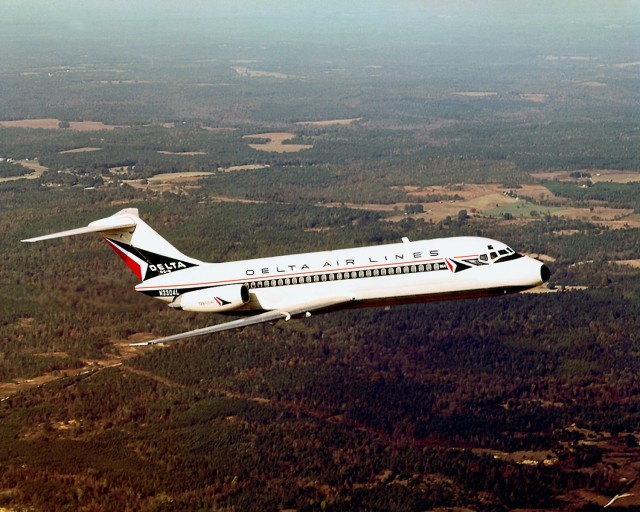
DC-9 “Delta Prince” in flight over wooded area, taken in the 1960’s. Image courtesy of Delta Air Lines.
This Story was Written by Andrew Vane for AirlineReporter.com:
Last summer I had the pleasure of writing an aircraft highlight article on the Mad Dogs and their history which began with the DC-9 and has brought us to the Boeing 717. About a year ago, Delta Air Lines, one of the last US airlines still operating the DC-9’s, announced that they would be retiring the last remaining 35 DC-9-50’s over the next 12-18 months. As of September 2011 the number of DC9’s in use was down to about 27.
In Fall 2011, I realized that I had to plan a business trip to Nashville from Charlotte for a national conference related to my work. While air travel is not usually a part of my work, I really enjoy choosing flights based on aircraft within my travel window, not only for comfort but for the experience. What I realized for this trip is that the Charlotte to Atlanta flights and Atlanta to Nashville flights afforded a wide selection in aircraft type from the telephone booth sized CRJ’s to the A319 and MD-88’s. What’s this? There are DC-9’s on that route?
This means I have an opportunity to actually fly in what’s likely to be a museum piece in the near future. I suddenly realized I had to jump on this opportunity to ride this workhorse of the short range market before the opportunity is gone. As it turns out, I managed to book 3 of my 4 flight legs on the glorious DC-9-50. Only my Atlanta to Nashville flight would be on a different aircraft; the Airbus 319) The table below highlights the aircraft I was privileged to fly in for this trip:
| Flight Leg | Aircraft Type | Registration | Year Built |
| Charlotte-Atlanta | DC-9-50 | N675MC | 1975 |
| Atlanta-Nashville | Airbus A319 | N302NB | 2000 |
| Nashville-Atlanta | DC-9-50 | N767NC | 1977 |
| Atlanta-Charlotte | DC-9-50 | N784NC | 1978 |
The DC-9 first entered service in 1965 with Delta as the launch customer. Delta eventually phased out the DC-9’s but reacquired them (along with Boeing 747’s and Airbus A319, A320 and A330’s) when it merged with Northwest Airlines in 2008.
I’ve been excited about this trip ever since I booked it last month with my company’s travel agent. If you’re looking for a luxurious flight experience, this aircraft is not the place to find it. Hopefully this article will contrast with the web site founder’s exotic meal laden VIP trips the rest of us common folk can only dream of taking. J My previous story on the Mad Dogs drew some comments regarding the smell of the lavatory wandering throughout the cabin. I sat right over the wing and couldn’t even smell a hint of the lavs. I could see every single rivet and bolt on the wing though.
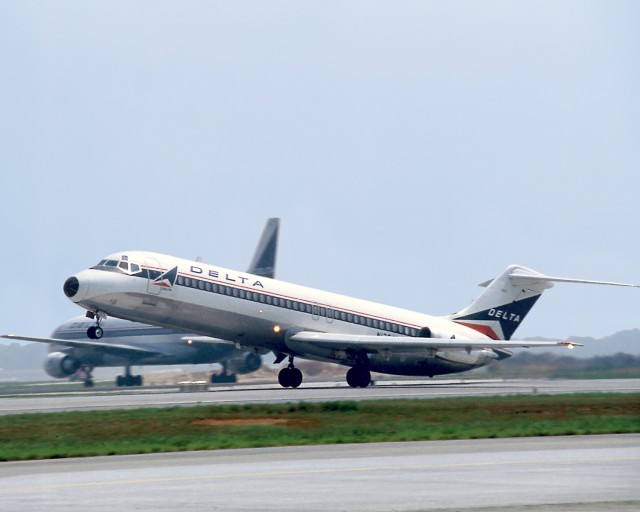
Delta DC-9 in updated livery. Check out the L1011 in the background. Image courtesy of Delta Air Lines.
As I strapped myself in, I couldn’t help but notice how modern the interior of Delta’s DC-9’s look. They’ve spared no expense in making you feel business as usual on all their aircraft, whether they’re 10 years old or 30. The captain came on and told us he was going to be starting the engines at the gate and that the lights would flicker a bit while he ran through some electrical checks. I almost expected to see some guy come out with a hand crank. I’m not sure if the gate startup is because they need ground power or for some other reason.
The DC-9 uses Pratt & Whiney JT8D turbojet engines with about 16,000 lbs of thrust each, the same type used by the 727, MD-88 and early versions of the 737. By contrast, the Airbus 319 uses European made CFM engines each are rated at 25,000 lbs of thrust each. I was thankful Charlotte has a 10,000 foot long runway because I figured we’d be needing all of it that day.
As expected, as we began our takeoff roll, I noticed it was taking quite a long time to get down the runway. It took a good 40 seconds to go from a rolling start to the hind wheels leaving the pavement. By comparison, the similarly sized A319 took 30 seconds to takeoff, but that was from a dead stop. The difference between engine thrust in the two aircraft was obvious. Still, the rumble in the DC-9 was definitely more fun an experience.
The flight went smoothly, the air conditioner worked, and we arrived right ’œon time,’ although I think the airline adds to the official travel time to allow for ground traffic and taxiing.
At the time of my travel in March, Hipmunk.com (an airline travel web site I frequent) showed Delta’s last DC-9 flights between Charlotte and Atlanta ending June 6th (being replaced with its longer MD88 cousin) and DC-9 flights from Atlanta to Memphis ending sometime in early October (being replaced with MD88’s and A319’s). However, one Delta pilot who took a lot of time after my first flight answering my questions told me Delta plans to fly DC-9’s at least for an additional year and plans a DC-9 ’œjet base’ for pilots in Atlanta. For now, I can postpone my farewell for at least another year or so.
Some of you fliers may enjoy the comfort and luxury of the newer aircraft. As I get older, I’m becoming more nostalgic and appreciating the older classics in life like a fine Merlot, Vivaldi and the DC-9.
I want to express my sincerest thanks to the Delta pilot Mark who took time to talk with me following each flight. My former landlord, a Delta 757 pilot, told me once after sitting in the jump seat of a DC-9 ’œBoy, those guys sure do work!’ Unlike the MD-80 series, the DC-9’s never received a cockpit upgrade. The pilots use nothing but the original steam gauges and fly VOR to VOR. While the newer aircraft with FMC’s let the aircraft fly the needle during cruise, the DC9 pilots often don’t know they’re off course until its too late. One pilot shared this with me and said he’d sometimes received ’œwhere are you going?’ questions from ATC after straying a bit off the route. ’œIf you’re within 4 miles you’re good,’ he told me.
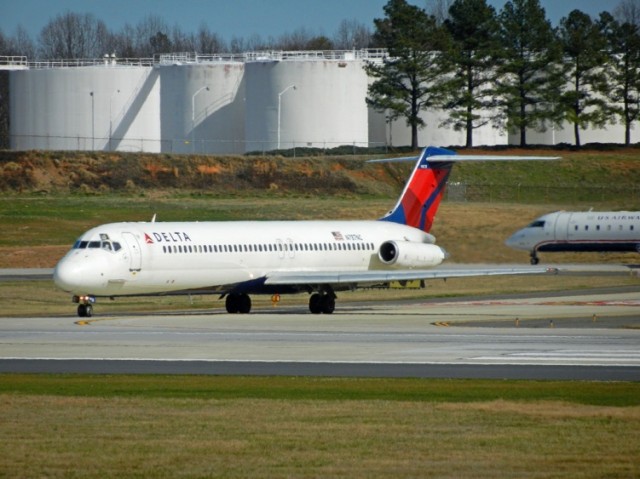
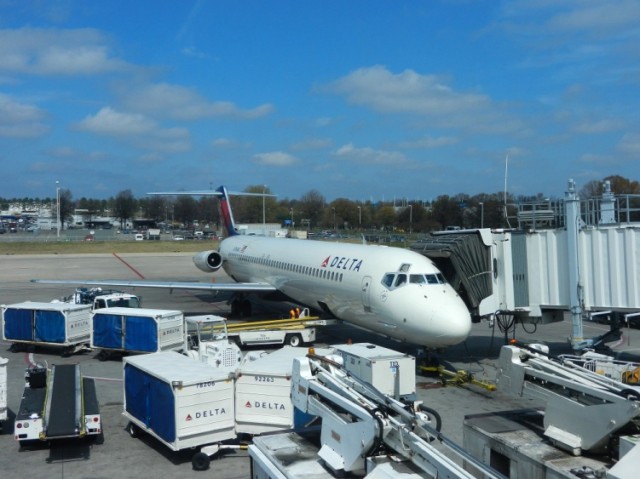
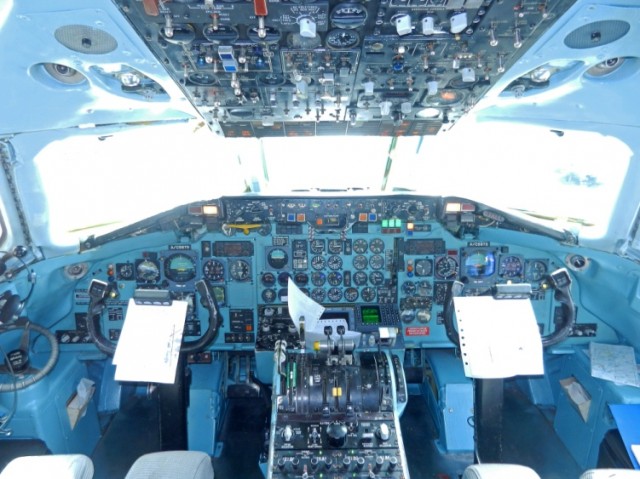
When they built the DC-9, I’m sure they didn’t expect it to ever have Wi-Fi!
Or the internet. Or computers. Or the iPhone… and I could keep going 🙂
David
Andrew : Great write-up. I love the DC9 series. Yeas ago, as an Air traffic controller, I flew in the jump seat of several Hughes Airwest DC9’s, both the model 10 and 30, including a milk run from SFO to SEA with 4 or 5 enroute stops. It seems that flying was more fun on these aircraft. I fear that the next generation of pilots will not have the basic skills to actually fly the aircraft and navigate using VORs, but will be more like computer operators and observers.
Andrew,
Great story. I have more than 10,000 hours in the Nine and enjoyed it tremendously. Flying without computers and auto-throttles was very satisfying. If you need any DC-9 shots in NWA livery let me know, I have many.
Rand
Well Rand — I want some 🙂
David
Thanks for the kind comments. I really enjoy contributing when the inspiration hits me.
The email link to the travel agent is broken. She does a great job and I wanted to give her a plug so here is here email for anyone wanting to schedule airline or hotel reservations jo*********@tr**********.com.
Hmmm. An ode to the DC-9? I live in the Dallas area, and I fly Super 80s once or twice every week. American still has 300 of them. The DC-9 isn’t dead yet by any means.
Nice post. I agree with John, however in that the DC9 is alive and well.
Wikipedia has a detailed paragraph describing how the move to “MD” was nothing more than a marketing move and that the airworthiness certificate states that these newer models are just 9 variants.
I live in Asia. Here, 9 means longevity. It is certainly true with the 9 as it is with the 8. There is a reason why these planes are still flying – Douglas made STRONG birds!
Variants, but not the DC-9. Just like the new 737MAX is a variant to the 737-200, but they are two different beasts.
I’m always amazed David how you romantize the most mundane of things in aviation , like the DC-9 which I really don’t remember today, in what is now an MD-83 and MD-90, but onward an upward as they say in aviation. Many traveller today can’t tell the difference or really car on way or the other.
Cool story on the -9. Lovin the teal! I am sure many pax will be happy to see them go the way of the dinosaur however.
Two comments:
1) Why fly Delta between CLT and BNA? USAirways offers non-stop flights?(mostly on 319s, but with some RJs thrown in) If you are in Sky Miles and had time to kill, I withdraw my question.
2) Let’s get the proper use of the apostrophe down, shall we? If you want to use the PLURAL form (“I saw many DC9s at ATL!”) then there is no apostrophe. If you want to use the POSSESSIVE form (“The DC9’s engines are turbojets, not turbofans.”) then you use the apostrophe. This is one of the most mis-used pronunciation forms these days. Shame on your college English comp teacher not beating that out of you!
If you’re going to get technical, it’s “DC-9”, not DC9. 🙂
Seems pretty obvious that he flew DL through Atlanta because he was looking to ride on the DC-9 – which was the point of this story. 🙂
I would have done the same thing. When compared to a ride on a DC-9, I have absolutely no interest in US Scareways, CRJs or anything Airbus. Come to thing of it, I have no interest in any of those options even if a DC-9 isn’t involved.
I’ve taken a few out of the way trips to ride on the original DC-9s (not the MD-81/82/83/87/88 variants), as well. Around a year-and-a-half ago, I flew BNA-DTW-MKE-DTW-BNA for no reason other than a chance to ride on as many of the remaining six DC-9-41s as possible (and some bonus miles, which were a distant second to the experience). I managed to ride on three of the last six (all still in old NWA silver livery), and one DC-9-51 in DL colors (with WiFi). I was upgraded to F on three legs, and had an exit row window on the fourth leg.
One month later, all six of those birds were ferried to Sanford, Florida and were scrapped – which is a damn shame.
Thanks for the comments Len and the english lesson. Yes, I probably had some jots and tiddles wrong. I’m not an english professor but will proof my articles in the future.
Yes, US has direct flights but they were more than twice the cost. While I’m on the company’s nickel, I do try to be as economical as possible. I’ll never fully understand the cost/marketing method to the madness.
Even if you accept the fact that MD-80s are technically a DC-9 (Note the MD-88 was certified as that and not a DC-9), it still doesn’t take away from Andrew’s article about flying on the last of the original “Nines.” To me, the original non MD-80 DC-9s are a separate breed, just like the 737-100 and 737-200 are much different aircraft than the NGs or even the Classics (-300s, etc). I think you have to accept that Douglas was famous for “morphing” designs. The DC-3 was a stretch DC-2. The DC-4 was stretched into the DC-6 and then the DC-7. I remember when enthusiasts, there were a lot fewer of us back then, made an effort to fly on the last remaining non-stretched DC-8s. So no, we are losing something when those DC-9-50s are retired.
Northwest Airlines did an avionics update to the DC-9s in the early 2000s. See the following newsbit from Avionics Magazine. McDonnell Douglas had been hopeful that Northwest would buy 717s to replace DC-9s, but they elected to do the avionics update instead due to the life expectancy left in the aircraft.
Tuesday, May 1, 2001
Industry Scan
New Displays for DC-9s
Northwest Airlines selected Universal Avionics Systems Corp.”s MFD-640 multifunction display for retrofit in its fleet of 162 DC-9 aircraft. The new color displays will replace RDR-1E and RDR-4A weather radar indicators, and it will display data from Honeywell”s terrain awareness warning system (TAWS). Northwest received the first MFD-640 in early March. Electronic Cable Specialists, Franklin, Wisc., is providing the STC certification and integration kits. Northwest says the MFD retrofit program will continue until March 2005. Visit http://www.uasc.com and http://www.ecsdirect.com.
Great article, Andrew! I have been flying commercially since July of 1981 and have flown on the DC-9 and it’s varients more than any other A/C. It is one of my favorite A/C due to it’s comfort and reliability. To date, I have flown over 540 segments on the ‘9’. This does not count the MD-80 series and MD-90 series, of which I have flown at least 40 segments. I started with ‘9’ on Republic Airlines, then Northwest and now Delta. Delta is still flying some of the ‘9s’ that North Central Airlines bought new in the 1970’s! That is a testament to how well built and economical these A/C are. Some of the other airlines I flew the ‘9’ on are American, Air Canada, Eastern, Continental, Hawaiian, Midwest, Ozark, Texas International, TWA and USAir. I look foward to flying a few more times on the ‘9’ with Delta before they retire them and anticipate a ride on the B717 (a ‘9’ variant) sometime soon on Delta.
“glorious”?!?!?!??!?!
3 of my last 4 DC-9 flights went MX on me. the planes need to make their way to the desert ASAP.
Stan, I am guessing you are not an airline geek 🙂
David
Unfortunately, here (in Brazil) I do not have a chance like this. You are a lucky guy…
When the last 787 is mothballed in Marana, the cockpit crew will most likely deadhead home on a DC9.
WHEN 19 YEARS OLD I WAS HIRED BY ALLEGHENY AIRLINES IN ALBANY NY.THE FIRST FLIGHT I WORKED WAS A CV-580 50-SEAT TURBO PROP AND 15 MINS LATER A BRAND NEW DC9-30 PULLED IN TO THE GATE.SHE WAS SOOO PRETTY!!..LAST JET I WORKED WAS AN A320 AT RDU,FOR USAIRWAYS,THE OLD ALLEGHNEY AIRLINES, WHEN I RETIRED IN 2005 AT THE AGE OF 52..33 YEARS WENT BY FAST!! ..AND I ENJOYED EVERY YEAR THERE.
The first modern air conditioning system was developed in 1902 by a young electrical engineer named Willis Haviland Carrier. It was designed to solve a humidity problem at the Sackett-Wilhelms Lithographing and Publishing Company in Brooklyn, N.Y. Paper stock at the plant would sometimes absorb moisture from the warm summer air, making it difficult to apply the layered inking techniques of the time. ..
My very own blog site
<.http://www.prettygoddess.com
Are the DC-9 aircraft that are put out of commercial airline service used for other purposes, such as freighters, business jets, etc. Is there any type of aftermarket for these aircraft. Note: We have recently purchased a large inventory of parts for the DC-9. Therefore if you want something for a momento of your flight, please advise.
Ed Wilk
I’m gone to ssay to my little brother, that he should also
ggo to see this eblog on regular basis to take updated from most recent nws update.
I know this site provides quality depending articles and additional stuff, is there any
other website which offers these kinds of data in quality?
Also visit my web site – claim (Deidre)